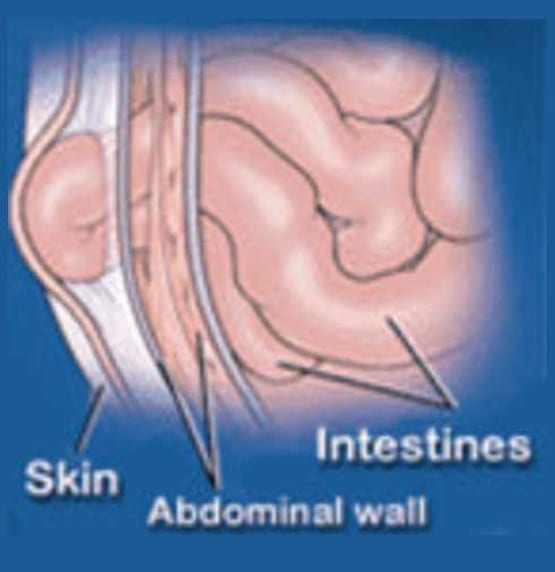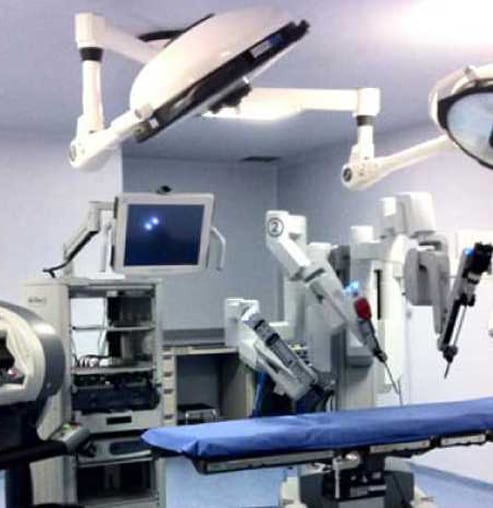Dr. Ara Keshishian offers Laparoscopic and Robotic inguinal hernia repair mostly as an outpatient procedure with minimal down time and discomfort. Dr. Ara Keshishian has more than 17 years of advanced surgical skill and expertise in both open and minimally invasive surgical hernia repairs.
Inguinal or Groin Hernia
A hernia is present when part of an internal organ or tissue bulges through a defect or weak area in the belly wall (fascia). The type of hernia you have depends on where it is and how it occurs. An inguinal (groin) hernia is a bulge of tissue through the inguinal canal in the lower abdomen in the groin area. There are many types of inguinal hernias and other groin hernias that are not inguinal (femoral hernia). These hernias can become a surgical emergency when the herniated abdominal organs (usually small bowel) are not reducible. An inguinal hernia doesn’t get better or resolve on its own and can lead to life-threatening complications. This can potentially result in bowel obstruction, and need for bowel resection.
The anatomy of the inguinal region is very complex. There are multiple structures, nerves or blood vessels that are located very close to each other within the inguinal canal. Both females and females inguinal canal is a conduit whereby the structures within the abdominal cavity connected to the outside of the abdominal content. This canal has potential weaknesses that can result in a hernia. A hernia in general refers to a weakness of a fascia plane. A fascia plane in most cases defines the boundaries of a space or a cavity, which is to hold surgical organs in a confined space.
Inguinal hernias can actually be either a “Direct” or and “Indirect” inguinal Hernia. The end result for the patient is the same with regards to the surgery. Inguinal Hernias are repaired by placement of a mesh laparoscopically in almost all cases. There are also some patients that may have a direct or an indirect component to their inguinal hernias, which are repaired all at the same time.
Dr. Ara Keshishian Introduces Robotic Surgery
Femoral Hernia
Another hernia that is less common, however is sometimes seen in the inguinal region is “Femoral” hernia. A hernia usually presents itself in the form a bulge. This may come slowly or appear over a short period of time, sometimes associated with an injury, heavy lifting etc.
Inguinal Hernias causes:
- Heavy lifting
- Strenuous exercise
- Coughing
- Obesity
- Genetics
- Other
The symptoms of an inguinal hernia vary. The most common symptom is the presence of a painful bulge in the groin area. Typically, inguinal hernias progressively increase in size and grow increasingly more uncomfortable with the passage of time. When no bulge is visible, mild pain in the groin region is present. However, some patients experience no pain at all. When the hernia becomes increasingly painful or stuck, it may be strangulated. If this occurs seek medical attention as soon as possible.
Surgical Treatment
In the last 20 years the technique of laparoscopic hernia repair as involved significantly. Historically, repair of an inguinal hernia and included both with and without mesh technique. Laparoscopic approach however involves placement of the mesh in different planes.
In all these hernia the principle of the repairs involves placement of the misplaced structures to their anatomically correct place. At the same time, a synthetic mesh is placed to reduce the chance of hernia recurrence. All Laparoscopic hernias are repaired by placement of the mesh. This reduces the chance of recurrence compared to the open procedures.
The patients are to avoid any strenuous activity for 4-6 weeks after surgery. The operation itself is done Robotically- laparoscopically, with 2-3 small incisions. There are all closed with absorbable stitches that do not need to be removed. Small dressings are placed that are removed in 1 day and the patient resumes shower and normal activity. Patients can drive as soon as they stop all narcotics for pain.
Surgery is the primary treatment for inguinal hernias. It’s a very common operation and a highly successful laparoscopic procedure.


